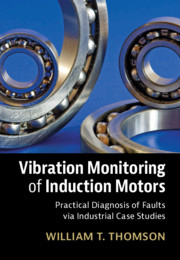Book contents
- Vibration Monitoring of Induction Motors
- Vibration Monitoring of Induction Motors
- Copyright page
- Contents
- Preface
- About the Author
- Acknowledgements
- Biographies of Personnel in the Acknowledgements
- Nomenclature
- Acronyms and Abbreviations
- Relevant Units of Equivalence Useful for this Book
- 1 Vibration Monitoring of Induction Motors and Case Histories on Shaft Misalignment and Soft Foot
- 2 Rolling Element Bearings for Induction Motors
- 3 Types of Defects in Rolling Element Bearings
- 4 Introduction to Vibration Spectrum Analysis to Diagnose Faults in Rolling Element Bearings in Induction Motors
- 5 Industrial Case Histories on VSA to Diagnose Cage Faults in Rolling Element Bearings of SCIMs
- 6 Industrial Case Histories – VSA Detected Inner and Outer Race Faults in Rolling Element Bearings in SCIMS
- 7 Industrial Case Histories – VSA Diagnosed False Brinelling and Problems in Cylindrical Roller Bearings in SCIMs
- 8 Industrial Case Histories on VSA to Diagnose Miscellaneous Faults in Rolling Element Bearings in SCIMS
- 9 Industrial Case Histories on Vibration Measurements and Analysis Applied to Large Induction Motors with Sleeve Bearings
- 10 Industrial Case Histories on Magnetic Forces and Vibration from Induction Motors
- 11 Miscellaneous Industrial Case Histories on Vibration Analysis Applied to Induction Motor Drives
- 12 Overview of Key Features of Vibration Monitoring of SCIMs
- Index
- References
4 - Introduction to Vibration Spectrum Analysis to Diagnose Faults in Rolling Element Bearings in Induction Motors
Published online by Cambridge University Press: 17 February 2021
- Vibration Monitoring of Induction Motors
- Vibration Monitoring of Induction Motors
- Copyright page
- Contents
- Preface
- About the Author
- Acknowledgements
- Biographies of Personnel in the Acknowledgements
- Nomenclature
- Acronyms and Abbreviations
- Relevant Units of Equivalence Useful for this Book
- 1 Vibration Monitoring of Induction Motors and Case Histories on Shaft Misalignment and Soft Foot
- 2 Rolling Element Bearings for Induction Motors
- 3 Types of Defects in Rolling Element Bearings
- 4 Introduction to Vibration Spectrum Analysis to Diagnose Faults in Rolling Element Bearings in Induction Motors
- 5 Industrial Case Histories on VSA to Diagnose Cage Faults in Rolling Element Bearings of SCIMs
- 6 Industrial Case Histories – VSA Detected Inner and Outer Race Faults in Rolling Element Bearings in SCIMS
- 7 Industrial Case Histories – VSA Diagnosed False Brinelling and Problems in Cylindrical Roller Bearings in SCIMs
- 8 Industrial Case Histories on VSA to Diagnose Miscellaneous Faults in Rolling Element Bearings in SCIMS
- 9 Industrial Case Histories on Vibration Measurements and Analysis Applied to Large Induction Motors with Sleeve Bearings
- 10 Industrial Case Histories on Magnetic Forces and Vibration from Induction Motors
- 11 Miscellaneous Industrial Case Histories on Vibration Analysis Applied to Induction Motor Drives
- 12 Overview of Key Features of Vibration Monitoring of SCIMs
- Index
- References
Summary
Chapter 4 presents an introduction to vibration spectrum analysis to diagnose faults in rolling element bearings in induction motors.This chapter is a precursor to the presentation of industrial case histories in Chapters 5 to 8 using conventional vibration spectrum analysis (VSA) to diagnose the onset of faults in rolling element bearings before actual bearing failures occur. It is emphasised that previously published books and papers that cover the theory and application of vibration monitoring to diagnose faults in rolling element bearings assume that vibration transducers such as accelerometers can be always placed on the bearing housings.In many cases access to bearing housings is not practically possible on induction motors and this a key fact which is demonstrated in this book.
- Type
- Chapter
- Information
- Vibration Monitoring of Induction MotorsPractical Diagnosis of Faults via Industrial Case Studies, pp. 75 - 89Publisher: Cambridge University PressPrint publication year: 2020



